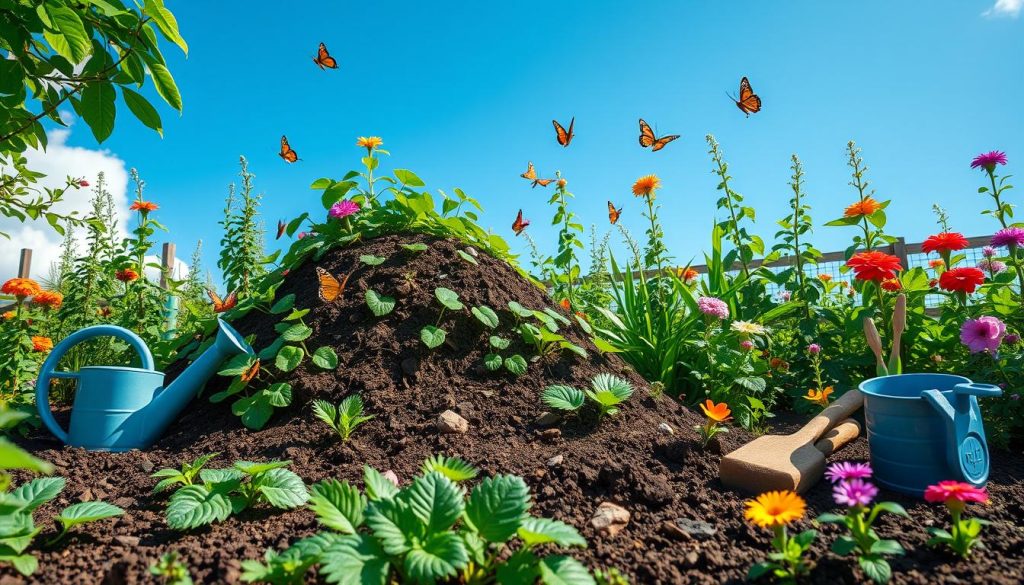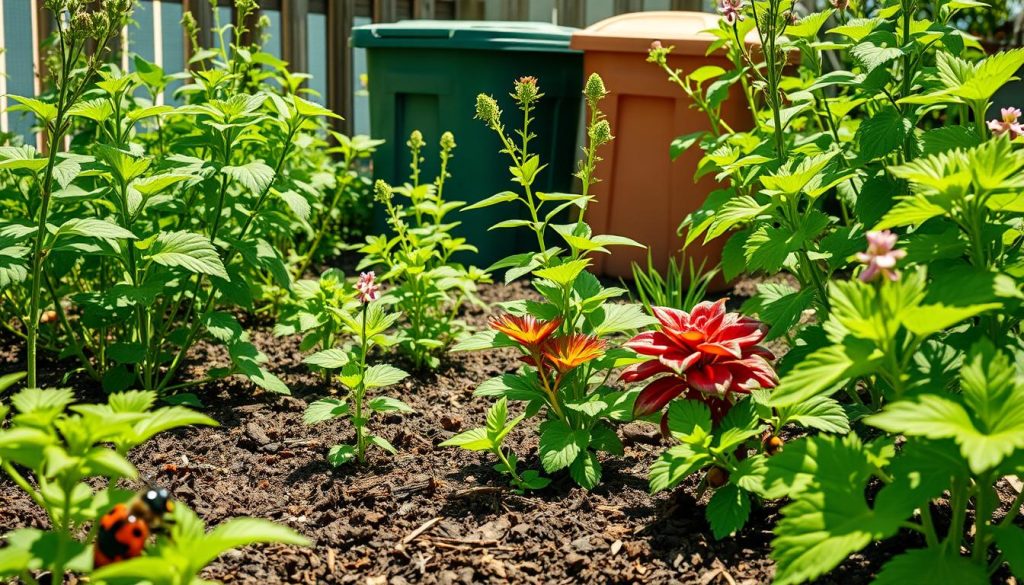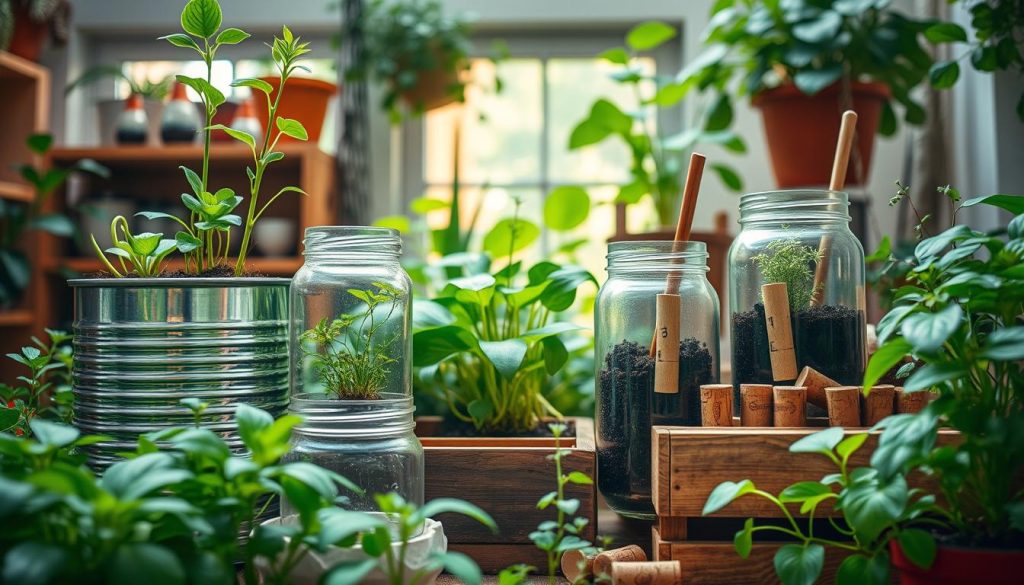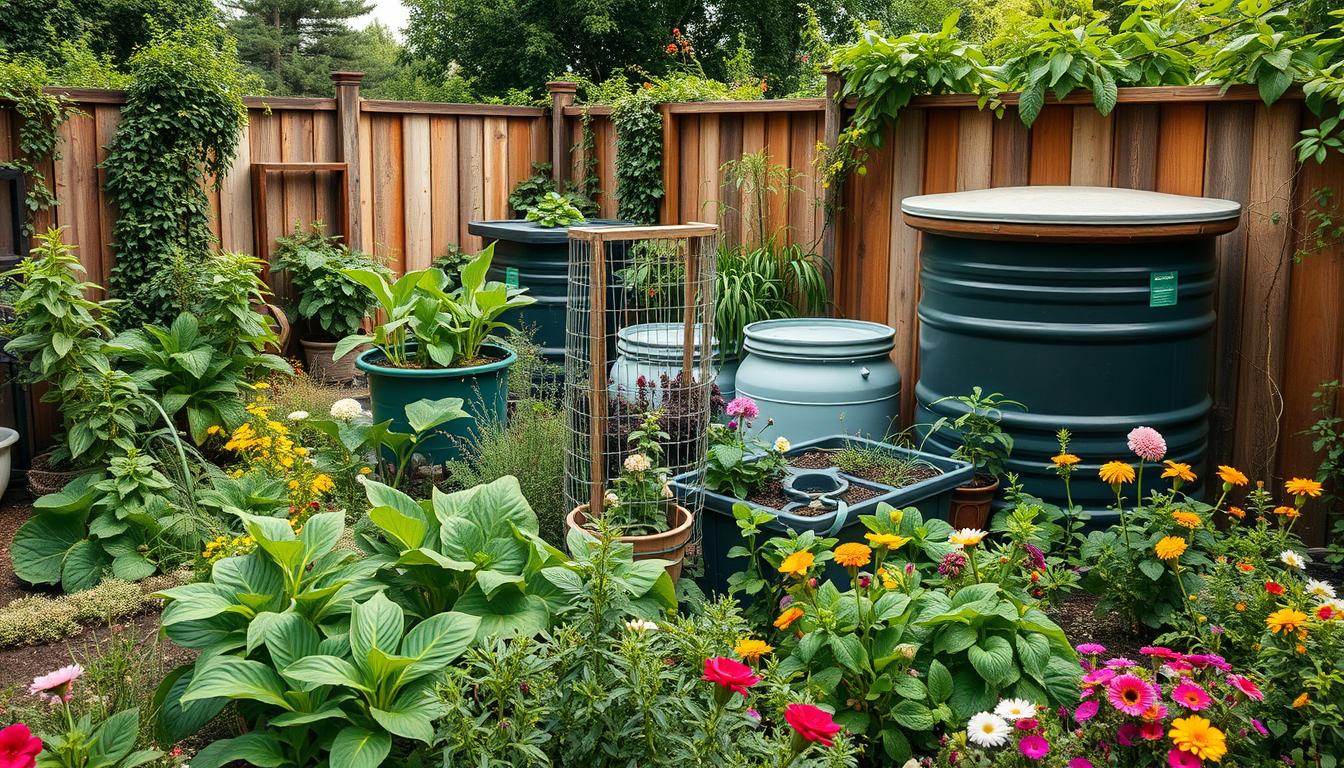I love gardening and want to help the planet. I use zero-waste methods to care for my plants. This makes my garden healthier and more sustainable.
Changing a few things can make a big difference. Using eco-friendly tips like composting and repurposing items helps a lot. These actions reduce waste and make our gardens better for the planet.
In this article, I’ll share my top tips for a zero-waste garden. We’ll talk about composting and using household items in new ways. These strategies help us care for our gardens without harming the environment.
Understanding Zero-Waste Practices for Plant Care
Exploring zero-waste gardening is exciting for me. It offers many benefits for my plants and the environment. By using eco-friendly methods, I can cut down on waste and make my garden sustainable. Zero-waste gardening means using compost and repurposing items instead of throwing them away.
Some key benefits of zero-waste gardening are:
- Conservation of natural resources
- Reduced greenhouse gas emissions
- Minimized waste sent to landfills
By adopting zero-waste gardening, I can make my garden healthier and greener. This helps my plants and supports a sustainable future. I’m looking forward to learning more about eco-friendly gardening methods.
Making small changes in gardening can make a big difference. Using compost and repurposing items are just a few ways to help. I’m excited to share what I learn and encourage others to join me in making our future greener.
Composting: The Heart of Sustainable Gardening
Exploring green gardening, I found composting key to eco-friendly plant care. It cuts down waste and makes a natural fertilizer for plants. Composting is a basic yet powerful way to care for plants every day.
To start composting, I pick the right stuff. I mix “green” items like food scraps and grass with “brown” ones like leaves and twigs. Good stuff for compost includes fruit peels, tea bags, and coffee grounds. But, I skip meat, dairy, and oils to avoid pests and bad smells.

How I Start My Compost Bin
I start with a 4-6 inch brown layer at the bottom, then green materials. I keep adding layers, ending with brown on top. This keeps it airy and prevents smells. I also keep it moist, like a damp sponge, to help it break down.
Composting Ingredients: What Works Best
- Fruit and vegetable peels
- Tea bags and coffee grounds
- Dried leaves and twigs
- Grass clippings and yard trimmings
Tips for Maintaining My Compost Pile
To keep my compost pile going, I turn it often for air and speed. I check its temperature, aiming for 130-140°F to kill off bad stuff. By doing these simple things, I make a garden that’s good for my plants and the planet.
Choosing Eco-Friendly Plant Protection Methods
To keep my plants safe, I choose methods that are good for the planet. I avoid using harmful chemicals. This helps me make my garden better for the environment.
Using natural pest control is one of my favorite tips. I use neem oil and soap solution to fight pests. I also plant different vegetables and flowers together. This helps keep pests away and makes plants grow better.
Natural Pest Control Solutions
- Neem oil: a natural insecticide that controls a wide range of pests
- Soap solution: a mild and non-toxic pesticide that can be used to control soft-bodied pests
- Diatomaceous earth: a natural substance that dehydrates and kills pests

Using Companion Planting Techniques
Companion planting makes my garden healthy and balanced. It helps me avoid using harmful chemicals. This way, my garden is better for the planet.
Repurposing Household Items for Plant Care
I’ve been looking into zero-waste plant care and found it’s key to reuse household items. This approach helps reduce waste and makes my garden more sustainable. It also saves me money. Using old containers, kitchen scraps, and other items creatively is very effective.
My favorite tricks include turning plastic bottles into self-watering planters and making planters from wooden crates. I also use kitchen scraps as natural fertilizers. These methods not only cut down on waste but also add a personal touch to my garden. By choosing zero-waste solutions, my garden is now thriving and eco-friendly.
Creative Ways to Use Old Containers
- Use old mason jars as mini greenhouses for seedlings
- Transform old wooden barrels into planters for herbs and succulents
- Utilize old plastic containers as pots for small plants and flowers

By using these creative, eco-friendly methods, I’ve made my garden more sustainable. Adopting green gardening strategies and eco-conscious care has helped my garden flourish. It’s now a haven for my plants and the environment.
Water Conservation Techniques for My Garden
As a gardener, I’ve learned that saving water is key for a sustainable garden. This is especially true in places where water is scarce. By using sustainable gardening practices, I cut down on water use and help my plants grow well. Collecting rainwater is a great way to save water, as it reduces the need for city water.
I’ve set up a rainwater harvesting system to collect and store rainwater. This system includes a roof catchment, gutter, and downspout to direct rainwater into a tank. I also use methods like mulching and drip irrigation to cut down on water loss. These methods ensure my plants get the right amount of water.
I love using drought-resistant plants like succulents and cacti. They’re perfect for saving water because they thrive in dry conditions. Adding these plants to my garden helps me use less water while keeping my garden beautiful and alive.
Effective Watering Strategies
- Water plants in the early morning or evening to reduce evaporation
- Use drip irrigation to deliver water directly to the roots of plants
- Mulch around plants to retain moisture and reduce runoff
By using these water-saving tips and eco-friendly care methods, I’ve made my garden sustainable. It not only saves water but also helps my plants grow strong and protects the environment.
Mulching: An Eco-Friendly Way to Protect Plants
Mulching is key in eco-friendly plant care. It keeps plants safe from hot and cold, holds moisture, and stops weeds. Using mulch makes your garden healthier and easier to care for.
There are many mulches to pick from, like wood chips, bark, and straw. These not only keep the soil moist and weed-free but also make your garden look good. Mulching helps me make my garden better for the planet and for my plants.
Benefits of Mulching
- Retains moisture in the soil, reducing the need for frequent watering
- Suppresses weeds, reducing the need for herbicides and other chemicals
- Regulates soil temperature, protecting plants from extreme temperatures
Mulching is a simple way to make your garden better. It saves water, stops weeds, and keeps plants safe. If you garden, try mulching to see how it helps your garden and the planet.
Sharing and Exchanging Plants and Resources
Starting a zero-waste garden doesn’t mean you’re alone. By joining my local gardening group, I found the joy of plant swaps and sharing resources.
These activities let me swap plants, cuttings, and seeds with other garden lovers. It cuts down on waste and makes my garden more diverse. I also pick up great tips from seasoned gardeners, helping me care for my plants better.
My go-to spots for plant swaps are community gardens, local nurseries, and online groups like Nextdoor and Facebook Marketplace. Through these connections, I’ve grown my knowledge of eco-friendly gardening. I’ve also made friends who love gardening as much as I do.
section>

